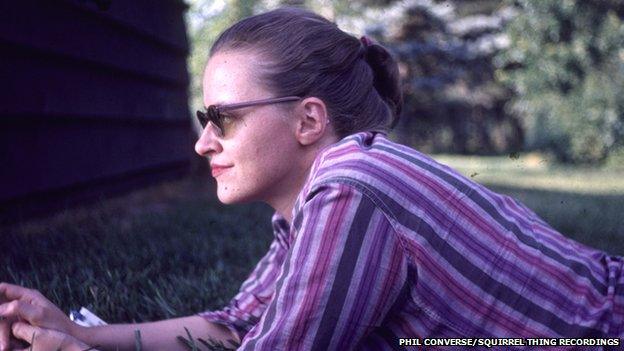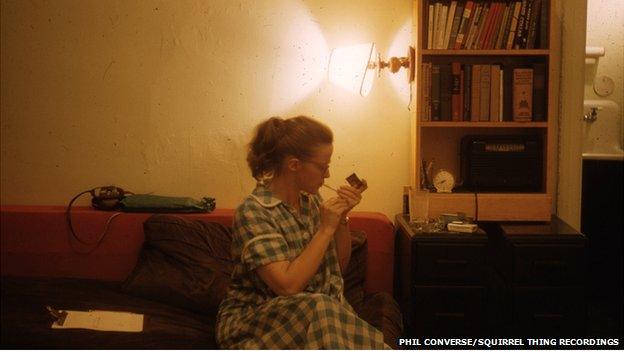Connie Converse: The mystery of the original singer-songwriter
- Published

Connie Converse remained virtually unknown after 12 years of trying to build a musical career in New York
Connie Converse was arguably the first modern singer-songwriter, writing and playing intimate songs on her acoustic guitar in the mid-1950s. But she remained virtually unknown and disappeared in 1974. Now, her talent is finally being recognised.
In summer 1974, days after her 50th birthday, Connie Converse sent fond letters to family and close friends telling them she wanted to make a fresh start.
Disillusioned with how her life had turned out, she packed her possessions into her Volkswagen Beetle and left her Michigan home.
She has not been seen since.
Twenty years earlier, Connie Converse was living in Greenwich Village, the New York district where, in the mid-1950s, beatniks and bohemians were carving out counterculture.

Converse made her only recordings in her apartment and in a friend's kitchen

She changed her name from Elizabeth to Connie after moving to New York
Converse was working for a printing firm, but had hopes of making it as a musician.
In her apartment, she would write haunting, beautiful songs with a poetic honesty and melodic sophistication that set her apart from the other singers in Greenwich Village.
With the folk scene still dominated by political and traditional songs at that time, the concept of the solo acoustic singer-songwriter had barely moved beyond Woody Guthrie and Pete Seeger's dust-bowl balladry.
Bob Dylan, Joan Baez and Joni Mitchell were still in school.
Converse was not the most gifted vocalist or guitar player, and her voice had an air of formality that befitted the age.
Yet when she sang, it was with a depth, intimacy and eloquence that were rare for that era.
Listen to the track, Talkin' Like You (Two Tall Mountains)
She sang of loneliness, of promiscuity, of quarrelling lovers, of frequenting saloons in the afternoons. While some tunes had a more jaunty, fireside air, most carried an underlying sense of sadness.
Despite her ambitions, she did not play conventional gigs and stood on the edge of Greenwich Village's musical coterie.
In 1954, she recorded a set of songs in the kitchen of Gene Deitch, who had recorded Pete Seeger and John Lee Hooker in the 1940s.
Deitch and her other friends tried to help her career, but to no avail.
In 1961, the year Dylan moved to Greenwich Village, Converse turned her back on her music career and left New York for a job at the University of Michigan.
Still unfulfilled, she fell into depression and heavy drinking.
She would be 90 now.
"The more I thought about it, the songs were all about herself," says Deitch, now 90, who went on to become an Oscar-winning animator.
"I think that's what makes the songs interesting. No matter what she was singing, it all had to do with sexual frustration and loneliness.
"There's something about those songs that was extremely personal. In those days, this was something you never heard.
"Nowadays, there are lots of women singers who you might call folk singers or personal song singers, who are doing pretty much the same thing as Connie did.
"But I think she was really the first."
Cult following
It seemed that Converse's songs were destined to be forgotten until Deitch's recordings were put out as an album by a small New York label in 2009.
Since then, the legend of Connie Converse has slowly grown.
"The music, considering when it was recorded, sounds eerily contemporary," says David Herman of Squirrel Thing Recordings, which released the album How Sad, How Lovely, external.
"Her voice is really compelling. Add to that the fact this was a woman writing singer-songwriter-style music in the mid-50s, before being a singer-songwriter was a thing, and before a female songwriter was something people were used to.
"And with the mystery of the disappearance, the whole thing leaves you with more questions than answers."
The next step in her rediscovery comes on Wednesday when a 40-minute documentary by US film-maker Andrea Kannes receives its premiere at the Sensoria film and music festival in Sheffield as part of a Connie Converse tribute night, external staged by British singer Nat Johnson.
'Funny and sad'
Kannes has had access to the filing cabinet Converse left behind, complete with her home recordings, letters and journals.
"It's almost like she wanted it to be found and looked through," Kannes says.
"What I found most fascinating was how funny she was in her writing.
"Here was a person who struggled through her whole life to feel successful, and you can tell there's a great sadness with a lot of the things she did and the way she lived her life, but she was also incredibly funny.
"You could tell that she was well liked and she had lots of friends. But there was still this wall between her and other people, where it didn't seem like she 100% connected with anybody."
As well as being frustrated in her music career, Converse had a powerful intellect that also never quite found its calling.
'A genius'
At high school, she dominated the graduation prize-giving ceremony and won a prestigious college scholarship.
But her parents were dismayed when she dropped out after two years and moved to New York, changing her name from Elizabeth and rejecting their strict teetotal, God-fearing upbringing.
After giving up on music and leaving New York, Converse edited the Journal of Conflict Resolution. She was also a keen political activist and a talented cartoonist.
Her brother Phil, writing in 2000, described her as "a genius and a polymath", adding: "I do not use the terms lightly."
She was also an enigma.
The mystery of what became of her remains unsolved. Her family believe she took her own life, probably by driving into a lake or river.
But 60 years after she made those recordings in Greenwich Village, Connie Converse's voice is finally being heard.